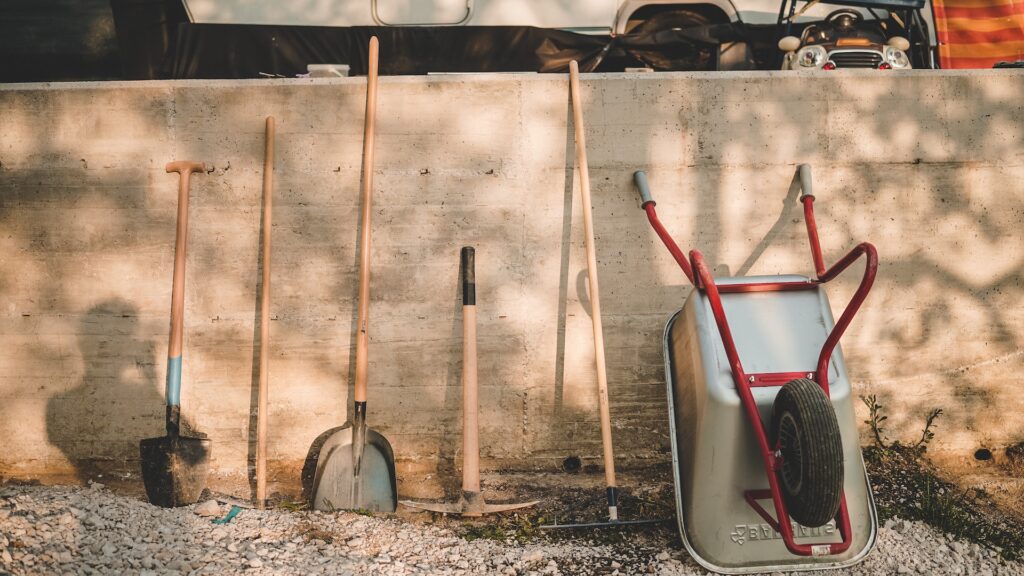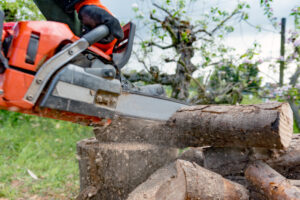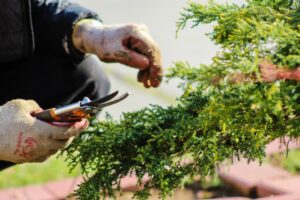Shrubs, bushes, and hedges are the landscape plants that are least recognised for their aesthetic value. Yet, they have a natural beauty that can make your property more appealing to potential buyers and be a charming addition to lawns, trees, gardens, and hardscapes like walks, patios, and stonewalls.
Several different kinds of bushes and shrubs can be grown along a boundary line to provide a privacy screen, windbreak, or live "fence." The majority of cultivars retain their lush green colour throughout the year. You can see a boost in the market value of your property if you take the time to prune and manage your shrubs, hedges, and bushes attractively.
Your home's curb appeal and value will suffer if you let its shrubs and bushes get out of control and allow them to become deformed and unmaintained. When you use a hedge trimmer, keeping this lovely landscaping in good condition is quite simple. In addition, a recent poll found that almost one-third of fathers prefer working on outside DIY projects to improve their home space. Growing and pruning hedges is a great activity to make a private escape in your own backyard, and the survey found that nearly one-third of fathers enjoy doing so.
The following provides an in-depth analysis of hedge clippers and instructions on properly trimming a hedge. There is also a brief conversation about how to protect oneself from getting hurt when using a hedge trimmer. Carefully read this section, and then consult the instruction manual that came with the trimmer for additional precise safety recommendations.
Cutting hedges for the first time
Hedge pruning should start as soon as the hedge has been planted, especially with flowering shrubs and robust non-flowering ones (hawthorn and privet). First, cut the plants down to roughly a third of their original height. This may seem like an extreme measure to take with green growth, but if you don't, the base of your hedge will constantly be sparse and full of weeds.
Then, in the next fall, trim new growth so that it is half as tall as it was, and then begin trimming new hedge shoots to the width you desire for the hedge. After planting, evergreens and slow-growing deciduous species, such as beech and hornbeam, should not have their foliage trimmed back. Instead, reduce the length of the side shoots by one-third, but allow the leading shoots to continue growing.
Although the hedge is lacking in thickness, keep your composure. When the plants have reached a height that is a few inches higher than the height you want the hedge to be, cut them. Because of this, there will be a lot of new side shoots, and the hedge will fill up much more quickly.
How to Correctly Trim Hedges
To accomplish this, you needed to continue away from the thicker branches that are jutting out. Continue pruning to maintain the hedge's neat appearance and good form. In an ideal situation, the base of the sides of a hedge is trimmed wider so that light from the sun may reach the leaves closer to the ground.
The chest-high side hedges should be trimmed first. Next, chest-high hedgerows should be trimmed by cutting the sides vertically with a sweeping motion that forms an arc. After that, trim the peak of the hedge. To accomplish this, hold the cutter bar horizontally while maintaining a little inclination of 10 degrees.
First, you should trim the top of tall hedges. Keep cutting the apex of the hedges with the appropriate cutter, angled at a 10-degree angle, and then begin cutting. Continue with the process of cutting the sides of the hedges.
Hedgerows must be properly maintained to retain their dense appearance and aesthetic appeal. In addition, they occasionally require fertiliser to provide them with the energy they need to continue growing and accelerate their development. Also, remember that if you find trimming hedges to be practically hard, you can always hire professionals to assist you in doing so.
Cutting hedge shapes
Remember that sophisticated hedge shapes require additional care before you begin pruning a hedge to create a complex profile. I was motivated to fashion a serpentine form out of a beech hedge after observing Christopher Wren's undulating crinkle-crankle wall in the garden at Wroxall, which is located in Warwickshire. The initial shape of the hedge was accomplished with the assistance of rope that had been spread out on the ground. Instead of the typical once-a-year trimming that is required of beech hedges, this particular hedge needs to be trimmed three times every year to maintain its crisp, clear line.
Take note that most formal hedges require shearing 3 - 4 times per year to keep their manicured and neat appearance. One or two shearings per year are all that is necessary for informal hedges, which are permitted to develop into a form that is more free-form in appearance.
Formal hedges
Utilising a hedge trimmer is the most effective method for shaping a formal hedge. It can be challenging to determine how much of a hedge should be trimmed; in reality, this is a matter of personal preference. If you want to maintain privacy in your and your neighbours' gardens, you shouldn't trim the hedges, so they are too short.
1. Determine how much of your hedge you want to remove before you begin.
2. If the hedge isn't too large, you should be able to cut it by simply looking at it. In that case, drive two wooden stakes into the ground, tie a piece of string to each stake, and position the string so that it is a centimetre or two below the height you want it to be.
3. Begin cutting away excess foliage from the head of the hedge so that it is level.
4. Make cuts all the way down the edge of your hedge. Make it so that the bottom of the hedge is broader than the top, creating a wedge-like shape with the hedge.
Informal hedges
Be sure to perform any necessary pruning on a hedge after it has flowered if you want it to maintain its shape. You should only prune these hedges once a year, but if you like, you can let them grow unpruned for longer. Since you won't need to remove as much foliage as you would with a formal hedge, it is more efficient for you to work using simple tools rather than a hedge trimmer. Make sure that the hedge-trimming tools you use are appropriate for the width of the branches.
Try a metal frame to cut your hedge.
Hedge-cutting guides can be purchased in the form of metal frames shaped like everything from sheep to Mickey Mouse. These frames can be used to cut hedges. When the plant has grown to the point where it has passed through the framework, clip it so it is close to the metal. After a few years have passed, the frame will be completely swallowed up by the shape. Ivy that is pruned in close proximity to wireframes will give the appearance of an immediate topiary. As a guide, you can create geometric shapes such as cubes, cones, and other figures by tying bamboo poles around the plant. Move the frame from shrub to shrub if multiple sections need to be trimmed to the same form.
"Lollipop" topiary is a simple and effective approach to provide an air of formality even in the smallest of gardens. For this purpose, Elaeagnus and hollies are the hardiest of all the plants. The clipped standard bay is prone to damage from frost, and it can soon look scorched and unsightly. August is the best time to cut hedges made of holly and Elaeagnus, but by the time winter comes around, when the sharpness of the balls is most crucial, they have started to make new, straggly vegetation.
At the conclusion of the fall, prune away any new growth, but don't cut too deeply because cold might cause damage to the plant. In the spring, take a pair of secateurs and cut the balls into a compact shape, making sure to cut through the stems rather than the leaves. If your hedge is located at a high elevation, you might need someone to direct you from the ground below. Be careful while you are pruning any type of hedge or topiary. It is preferable to make a second cut instead of waiting for a hedge clipped too vigorously to grow back than waiting. Here is our comprehensive guide to topiary.

What hedge-trimming equipment do I need?
To do the task successfully, you will require various instruments, depending on whether you want to make little or more significant adjustments. The following pieces of hedge-trimming gear come highly recommended by our team for producing the greatest results:
Pruning shears are another name for secateurs, which are basically just specialised scissors designed for use in the garden. They are perfect for trimming off small portions of your hedges and shrubs to make them look more presentable. The optimum branches for secateurs are those that are no thicker than 2 centimetres.
Loppers are a type of tool similar to secateurs but have longer handles and can cut through thicker branches. When the handles are longer, there is less of a demand placed on the user to exert themselves. To cut branches with a diameter of less than about 5 centimetres, use loppers.
Saw with a curved blade: When cutting through heavier branches, use a saw that has a curved blade. Long, slow strokes that make use of the entirety of the blade will produce the best results. Unfortunately, not even the thickest branches will have a chance to survive this.
Shears: Your shears are essentially a larger version of your scissors, making them the ideal tool for trimming back overgrown hedges.
In contrast to the other equipment, hedge trimmers are specifically built to simplify the trimming process. Their steel blades can be powered by electricity, gasoline, or batteries, making them ideal for trimming even the thickest bushes and hedges in your yard.
Safety Concerns
Hedge trimmers are incredibly user-friendly and entertaining to operate. They worked at the speed of light and with the meticulous accuracy of a Hollywood hairstylist. But, on the other hand, there is a risk involved in using them. Because of this, it is of the utmost importance to keep both hands on the trimmer at all times, and you should under no circumstances attempt to cut a branch while holding it in one hand and trimming it with the other. The likelihood of suffering a severe injury is simply too great.
You must constantly remain aware of your surroundings when using a hedge trimmer. The work area should be cleared of obstructions, and you should look for hoses and lines that may conceal the hedge. Make sure children and animals are kept at a safe distance away from the area. You must consider the extension cable when working with a corded electric trimmer.
Lastly, ensure you protect your eyes and ears with safety goggles and ear muffs, work gloves, a long-sleeved shirt, slacks, and shoes with closed toes.
A useful piece of advice is to carry a pair of bypass hand pruners in the back pocket of your work pants. These can be used to cut branches that are either too thick to be chopped with the trimmer or placed in an area that is particularly difficult to access.
Simple Tips for Organisation Trimming Process
1. In addition to shearing, it is essential to perform hand pruning.
Hedgerows can be kept nice and tidy with the help of shears, which can be either hand-held pruners with long scissor-like blades or power trimmers. Using shears to cut off the tips of branches helps stimulate bud creation towards the plants' edges.
However, when buds develop, a shrub may become so dense that sunlight cannot penetrate it, inhibiting growth on the interior. The end effect is a hedge that grows in size but appears lifeless on the inside. On the other hand, the right pruning lets in some light and enables you to keep shrubs from growing to unmanageable proportions by removing branches and cutting them back.
Therefore, after each shearing, you should create holes in the hedge for air and light by using hand pruners with a bypass mechanism. Then, reach inside the plant every few feet and cut one or two branches at a 45-degree angle, right above a nub or leaflet that is growing in the direction you want to encourage the plant to grow.
The three-year rule is a good guideline when performing rejuvenation pruning on an older hedge that has become severely overgrown. To encourage new development, cut off up to one-third of the thickest stems around the plant's base. Then, perform this procedure again the following year and the year after. As a result, you will have a shrub that is in better health and smaller in size.
2. Do your pruning in the wintertime.
In the best-case scenario, hedging should be pruned in the late winter, when the plants are asleep and have not yet formed buds. This is especially true if you intend to cut back significantly. Most gardeners argue that you should avoid letting the buds open before pruning since you want the plant's energy to develop new growth in the areas where you want it. If you remove the buds from a plant, you are preventing the plant from recycling its spent energy. As a result, the hedge will take more time to become full.
Evergreens, in particular, must be pruned at the beginning of the season. Because evergreens are typically slower-growing than other types of plants, they are more likely to be bare (in the areas where interior cuts have been made) and discoloured at the tips (too yellow) well into the summer, when new growth begins to emerge.
Deciduous hedging plants that grow more quickly, such as spirea, privet, and viburnum, are more tolerant of human error. Waiting until the day after blossoms have turned brown is the cardinal rule of trimming flowering shrubs. This allows the plant to have time to form buds for the following year, regardless of whether it blooms on the wood from the current season or the wood from the following season.
3. The tops of hedges should be cut to a narrower width, and the bottoms should be cut to a broader width.
If they are allowed to grow unchecked, most hedges will begin to spread out towards the peak, where they are exposed to the most sunlight. This creates a V-shaped canopy that casts shadows on lower branches, causing those branches to generate ever-decreasing amounts of foliage. Gardeners advise that the V shape should be inverted before it is used. Whether the top is flat, pointed, or rounded, the bottom of a sheared hedge should always be wider than the top, while the top should always be narrower.
Begin at the bottom and work up to the top when you shear. You may also run a string line between the stakes to guarantee an even line along the top for ultimate precision cutting, but gardeners prefer to rely on his eye for a more natural appearance. Again, this is because he wants the cut to look like it happened naturally.
It is important to remember that once you have buzz-cut the top of a plant, it will not shed snow as easily, making it more susceptible to snow damage (broken branches). The usage of hose-covered cable, which can wrap the trunks of the trees if left on for an extended period, should be avoided when tying up tall hedges for the winter. Instead, a rope or chain lock (a plastic tree-guying material) can be utilised.

4. Before planting, determine the height and width of the hedge you want.
Choose plants that lend themselves to producing a hedge, which means they naturally grow erect and tight—the terms 'columnar' or 'fastigiate' in the name imply that kind of growth habit—if you are starting from scratch, select plants that lend themselves to making a hedge.
Privet, yew, and boxwood are examples of shrubs that can withstand shearing and repeated pruning and are, therefore, suitable for use in formal hedges. A minimum width of three feet is required for a hedge. In terms of height, trimming your hedge so that it is almost at eye level will make it simpler; alternatively, you need to be prepared to use a ladder to reach the higher areas of the hedge.
Before you begin planting, it is in your best interest to determine the height and width of the hedge you wish to create. Research the growth pattern of any plant you wish to use as a hedge, then select a kind that won't outgrow the available area. Your efforts to trim the hedge down to size will be like pushing uphill against a strong current."
The western arborvitae, juniper, cypress, eastern red cedar, hemlock, fastigiate white pine, and some types of holly are all excellent candidates for larger, more naturally shaped evergreen hedges that require less trimming. Other options include some species of holly. In addition, flowering shrubs such as forsythia, lilac, rose of sharon, hydrangea, crape myrtle, or rugosa roses could be used to create informal hedges in areas where four-season foliage is not required.
5. Make sure you distinguish between a hedge and private plants.
Expecting a hedge to provide a significant amount of privacy or to obstruct an undesirable view is unrealistic. In most cases, hedges are trimmed to a height of between 6 and 8 feet, although privacy plantings can reach heights of up to 30 feet. Generally, screen plantings are considerably larger as well. They are made up of a variety of deciduous and evergreen trees, shrubs, and perennials spaced out in a staggered pattern to provide a natural appearance. You should let a hedge function as it was intended: as an aesthetically pleasing shrub border that completely covers your yard and unifies the landscape. "Start looking at large trees if seclusion is something that's important to you."
Summary
In conclusion, remember that if you initially use a hedge trimmer, you will most likely experience some awkwardness and trepidation, but you should not become disheartened by these feelings. Within an hour or two, you'll become used to how the trimmer works in your hands and grow comfortable with it. Remember that you shouldn't rush; you should operate steadily and let the blades cut. You won't need a teacher for long until you can trim hedges like an expert.
Frequently Asked Questions
What Do I Do with the Clippings After Trimming?
After trimming your hedges, it's important to clean up. Smaller trimmings can be left to decompose and add nutrients back into the soil, but larger cuttings should be collected and disposed of properly to keep the garden tidy. They can be composted in your compost heap, if you have one, or you can dispose of them in your green waste bin if your local waste management supports it.
How Do I Trim Hedges to Encourage Growth?
To encourage growth, make sure you're trimming your hedges at the right time - usually late winter or early spring for most hedges. During this time, cut back the tips of the branches to just above a bud to encourage branching. Regular light trims can also encourage denser growth.
Remember to keep your hedges well-watered and fertilized as well, as proper nutrition is important for growth.
Can I Trim My Neighbour's Hedge?
In most jurisdictions, you have the right to trim any branches or roots that cross into your property. However, you can't go onto your neighbour's property or cause the hedge to die by over-trimming. It's always best to discuss the matter with your neighbour first to avoid any disputes.
How Much Should I Trim Off My Hedges?
How much you should trim off your hedges largely depends on their current state and your desired final shape. As a rule of thumb, don't remove more than one-third of the branch length in a single trimming session.
For newly planted hedges, light formative pruning is recommended for the first couple of years to help them establish a good shape. For mature hedges, trim to maintain the desired size and shape.
How Do I Handle Overgrown Hedges?
Overgrown hedges can be a challenge. You may be able to restore them by hard pruning. This involves cutting back the hedge drastically, sometimes almost to the ground. It's best done in late winter or early spring, just before the onset of growth.
However, not all types of hedges respond well to hard pruning. If you're unsure, it's a good idea to consult a professional or a local nursery.







